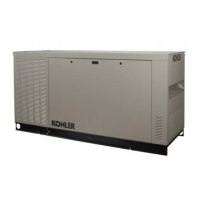TP-5737 5/01 31Section 5 Decision-Makert 3+ Troubleshooting
5.1.2 Fault Shutdowns,
Decision-Maker 3+ Controller
If the generator set does not start or stops running
because of a fault shutdown (fault lamp lit), refer to
Figure 5-13 to identify fault conditions. Consult the
Engine Service Manual for detailed information on
correcting engine-related faults. To reset the set after a
fault shutdown, see Section 2, Operation.
Indicator Fault Condition/Causes
Hi
hen
ine tem
erature lam
Engine coolant temperature is above shutdown range; see Section 1, Specifications
lights
Cooling system malfunction
Low oil pressure lamp lights Engine oil pressure is below shutdown range, see Section 1, Specifications
Overspeed lamp lights Governed frequency is in excess of 70 Hz (2100 rpm)
Continuous cranking is more than 45 seconds
Overcrank lamp lights
Cyclic cranking is more than 75 seconds
Locked rotor
Overcrank lamp flashes Speed sensor signal is absent longer than one second
No AC output is present
Auxiliary lamp flashes
Battery power was reconnected or was low and then came back up again while generator
set master switch was in the RUN or AUTO position
Optional emergency stop switch is reset while the generator set master switch is in the RUN
or AUTO position
High exhaust temperature (P1-14) or auxiliary delay shutdown (P1-15) faults occur,if sensor
equipped
u
iliary lamp lights
Overvoltage, if equipped, has occurred, voltage 15% greater than nominal voltage (for
period longer than two seconds)
Activated by customer-supplied sensing device connected to auxiliary immediate shutdown
ports (P1-17 and P1-18)
Emergency stop switch is activated (local or remote)
Emergency stop, i
equipped
Emergency stop switch(es) are disconnected from controller terminals TB1-1 or 1A
Multiple lamps light (where
illumination may appear dim)
Main circuit board F1 (3-amp) fuse blown. F1 fuse supplies battery voltage to a remote
annunciator and/or dry contact kit.
Figure 5 -13 Fault Shutdown Troubleshooting Chart

